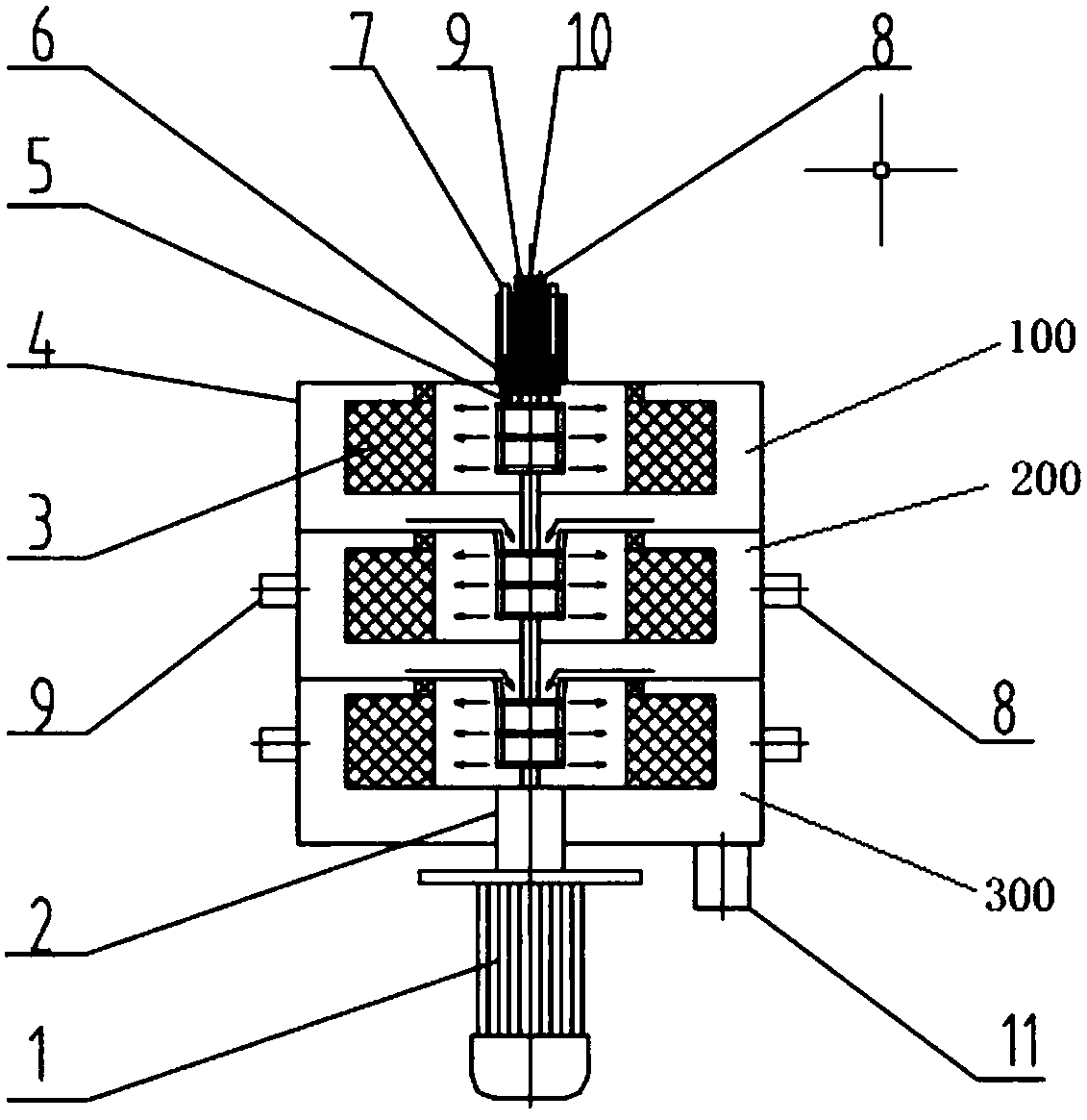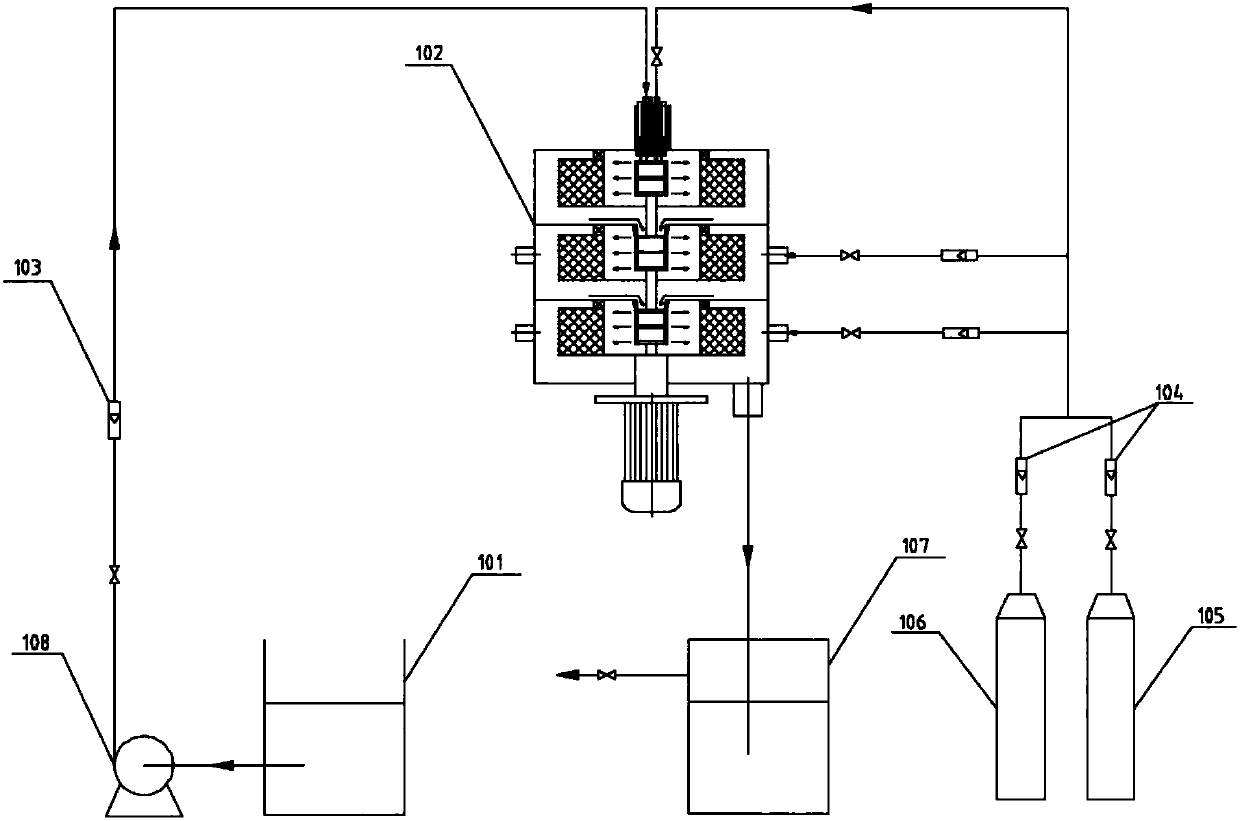Method for hydrogenation of heavy oil with multistage supergravity reactor
A hypergravity reactor, heavy oil hydrogenation technology, applied in chemical instruments and methods, processing hydrocarbon oil, petroleum industry, etc., to achieve the effect of reducing investment, reducing investment costs, and reducing floor space
- Summary
- Abstract
- Description
- Claims
- Application Information
AI Technical Summary
Problems solved by technology
Method used
Image
Examples
Embodiment 1
[0059] Such as figure 2 Shown, a method for hydrogenation of heavy oil in a multi-stage hypergravity reactor to remove sulfur, nitrogen and vanadium and nickel in the metal in the heavy oil;
[0060] The temperature of the heavy oil hydrogenation reaction in the supergravity reactor is 330-460°C, the pressure is 4-9MPa, and the flow rate of the gas phase is controlled to be 1m 3 / h, the liquid phase flow rate is 10L / h, the catalyst is packed in the rotor area in disordered bulk, the asphaltene in imported heavy oil is 3.3%wt, the mass fraction of sulfur is 2.79%, the mass fraction of nitrogen is 0.43%, and the vanadium content It is 1.5 μg / g, and the content of nickel is 50 μg / g.
[0061] After the reaction, the deasphaltene at the final liquid outlet reaches 50%, the demetallization reaches 80%, the desulfurization rate reaches 88%, and the nitrogen removal rate reaches 45%. Adopt conventional high-gravity reactors (for example, the disclosed high-gravity reactor of Chines...
Embodiment 2
[0063] Such as figure 2 Shown, a kind of heavy oil hydrogenation method of multi-stage supergravity reactor, to remove sulfur in heavy oil, nitrogen and vanadium and nickel in metal; Operation steps are the same as embodiment 1, difference is:
[0064] The rotating speed is 2400rpm, the temperature is 550°C, and the pressure is 10MPa under the operating conditions,
[0065] After the reaction, the deasphaltene at the final liquid outlet reaches 60%, the demetallization reaches 85%, the desulfurization rate reaches 90%, and the nitrogen removal rate reaches 50%.
[0066] Adopt conventional high-gravity reactors (for example, the disclosed high-gravity reactor of Chinese patent application CN103102942A or the disclosed high-gravity reactor of CN104419454A), the liquid outlet desulfurization rate≦80%, denitrification rate≦21%, demetallization≦50%, and desulfurization rate≦80%. Asphaltenes≦30%, the invention is obviously superior to the existing hydrogenation process in a high-g...
Embodiment 3
[0068] Such as figure 2 Shown, a kind of heavy oil hydrogenation method of multi-stage supergravity reactor, to remove sulfur in heavy oil, nitrogen and vanadium and nickel in metal; Operation steps are the same as embodiment 1, difference is:
[0069] The rotor area of the rotating bed is divided into 8 layers of concentric rings, the first layer is a stainless steel wire mesh packing ring, and the packing rings and catalyst rings are placed alternately, along the radius of the rotor are desulfurization, denitrification, demetallization of vanadium and demetallization of nickel catalyst.
[0070] After the reaction, the asphaltene removal rate of the final liquid outlet reaches 65%, the demetallization rate reaches 88%, the desulfurization rate reaches 92%, and the nitrogen removal rate reaches 60%.
[0071] Adopt conventional high-gravity reactors (for example, the disclosed high-gravity reactor of Chinese patent application CN103102942A or the disclosed high-gravity rea...
PUM
 Login to View More
Login to View More Abstract
Description
Claims
Application Information
 Login to View More
Login to View More - R&D
- Intellectual Property
- Life Sciences
- Materials
- Tech Scout
- Unparalleled Data Quality
- Higher Quality Content
- 60% Fewer Hallucinations
Browse by: Latest US Patents, China's latest patents, Technical Efficacy Thesaurus, Application Domain, Technology Topic, Popular Technical Reports.
© 2025 PatSnap. All rights reserved.Legal|Privacy policy|Modern Slavery Act Transparency Statement|Sitemap|About US| Contact US: help@patsnap.com


